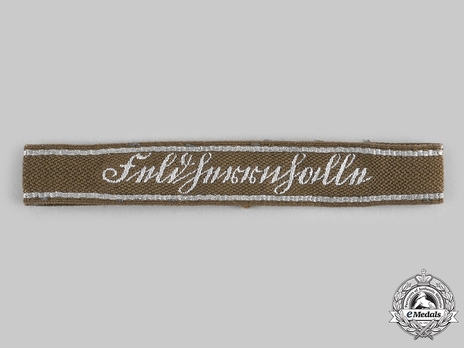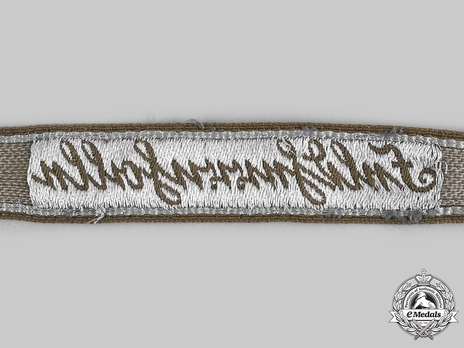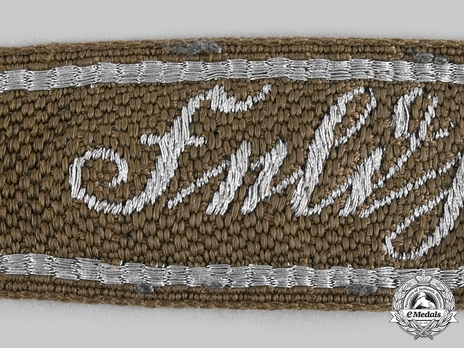SA Feldherrnhalle Cuff Title
CATEGORY: Version
SKU: 51.GOR.03.02.04.02.004.000
Estimated market value:



Estimated market value:
Constructed of a ribbed olive-drab rayon blend, the exterior trimmed along both the top and bottom edges with machine-embroidered silver aluminum wire, bearing an inscription of “FELDHERRNHALLE” in cursive script, unmarked, measuring 30 mm (w) x 355 mm (l), in uniform-removed and extremely fine condition.
The SA (Sturmabteilung, storm detachment) was established in 1921 as a paramilitary protection squad of the NSDAP. The members of the SA were tasked with protecting party leaders at political rallies and meetings from the paramilitary forces of the opposing political factions. The SA was first utilised on November 4, 1921 at a meeting held in Munich’s "Hofbräuhaus" beer hall. The organisation was banned after the failed putsch in 1923 and was reactivated in February 1925.
In general, SA cuff titles were manufactured out of 30mm wide strips of black cloth and were embroidered in grey or off-white silk/thread. Exceptions to this rule exist. Initially, the cuff titles were embroidered in Sütterlin script, but they were later produced using a Gothic script. In general, the capital letters are 19mm high and the lowercase letters are 15mm. The cuff titles were worn on the lower left sleeve of the brown shirt, service tunic, or greatcoat, approximately 10 cm above the shirt’s cuff.
There are numerous distinct categories of cuff title based on the method of production.
Machine-embroidered cuff titles were manufactured by machine-embroidering wording or numbers onto a strip of blank cuff title material. The embroidery was usually done in white/silver/grey thread and the thickness varies. The average length of this style of cuff title is 49cm, with the shortest being 41cm and the longest as 50cm.
These cuff titles are generally found with an RZM paper or woven label attached to the reverse, although it is not uncommon for the label to be missing. At times, a cuff title would have two labels attached as two different manufacturers were responsible for the production of the items (one firm produced the band, the other did the embroidery work).
Hand-embroidered cuff titles were produced by hand-embroidering wording/numbers onto a blank cuff title. Fine aluminum wires were generally used in the production of these cuff titles, although silver and gold thread, as well as yellow or white synthetic thread, were also used. These cuff titles are generally found with RZM paper or woven labels. This style of manufacture was popular until 1939/1940 and fell out of favour due to the cost.
Another type of cuff title is machine-woven, which was produced by feeding coloured threads into a machine where they are woven into a design.
Woven flatwire cuff titles were produced using aluminium, silver, white celleon, or gold/yellow celleon to create wording/numbering. The term ‘flatwire’ refers to the fact that the fine threads lay flat, unlike hand-embroidery which is raised. There are two types of flat wire weave cuff titles, form 1 and form 2.
Form 1 flat wire weave cuff titles feature a salt-and-pepper reverse and form 2 flat wire weave cuff titles feature an all-black reverse with a protective cloth backing sewn over the wording. The inscription on form 2 was produced using much finer aluminium thread than form 1.
The Feldherrnhalle Cuff Title was worn by members of the Standarte Feldherrnhalle, an elite guard unit tasked with guarding the NSDAP party offices.

Comments
Sign in to comment and reply.


Scroll Top